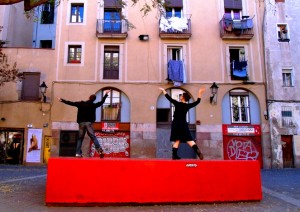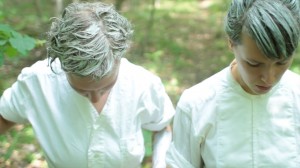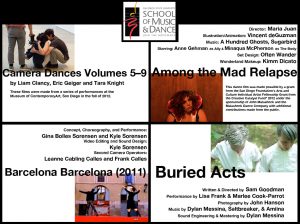Dance film asks, What does it mean to be in a body?
The first dance filmmaker was Thomas Edison. In 1894 he filmed modern dance pioneer Ruth St. Dennis doing a skirt dance. And a lot of dance film since then has involved filmmakers essentially pointing a camera at dancers, which is no small art–consider the brilliance of Hollywood musicals and PBS’s “Dance in America.”
 Another major direction in dance filmmaking goes back to avant garde artist Maya Deren. In the work of Deren and her descendants, dance film is a hybrid art form in which film techniques fracture fundamental dance elements of time and space, and gestural language may figure in a surreal landscape of images.
Another major direction in dance filmmaking goes back to avant garde artist Maya Deren. In the work of Deren and her descendants, dance film is a hybrid art form in which film techniques fracture fundamental dance elements of time and space, and gestural language may figure in a surreal landscape of images.
The four films shown at “Dance for Camera” at SDSU on Saturday reflected Deren’s legacy. The work ranged from accomplished and charming–“Camera Dances Volumes 5-9”–to problematic. Even the less successful work was interesting, though, and, since all of the artists are based here, it was exciting just to realize there’s a dance film scene happening locally. Thanks to Kristopher Apple for producing the show.
The delightful “Camera Dances Volumes 5-9” was made by video artist Tara Knight and dance artists Liam Clancy and Eric Geiger. Shot in a variety of settings at the Museum of Contemporary Art downtown, it’s structured as chapters announced by title shots. Often a title sets up a movement exercise, for instance, “Travel North to South”–which sounds so ordinary, isn’t that what we do all the time, but here the ordinary gets teased apart, to funny and illuminating effect. Clancy and Geiger stand tensed like runners at a starting gate, joking about how difficult this is. They explore quirky ways to move–falling over each other, lying down and pushing along the floor. They make it partway, but then a cut puts them back at the beginning. You can see some of these here.
Knight primarily does the filming, but she and the camera are also part of the dance. She gets on the floor with Clancy and Geiger to shoot intimate closeups of an ankle or intertwined limbs, or circles the men as they turn. Sometimes she’s in the frame, connecting with them physically or just watching.
Cuts are done with a light hand, which lets us focus on the dancers–Geiger lyrical and muscular, Clancy acrobatic and brainy (I don’t know how the braininess comes across, but I feel like I can see gears turning in his mind). And we get to really see the various backdrops: a painting, a sculpture, the view of downtown through a picture window. Best of all, Clancy and Geiger emerge as personalities whose playful exploration ultimately raises juicy questions: What is this thing we do to get from point A to point B? What does it mean to be in a body?
In contrast to the restrained use of cinematic tricks in “Camera Dances 5-9,” the film by Gina Bolles Sorensen and Kyle  Sorensen gave me a sense of artists playing with a fabulous box of new toys … and made me look forward to seeing their work develop. In “Barcelona Barcelona,” the Sorensens dance in several locations in Barcelona, Spain. Both of them are wonderful movers, but for me everything else took a back seat to speed, both visually–with dizzyingly quick cuts from one spot to another–and in terms of the score, which I recall as a fuzzy male voice repeating an unintelligible phrase with an insistent back-beat. Kyle Sorensen did both video editing and sound design, and maybe it’s just the gap between a young male sensibility and mine, but I kept wanting them to really connect with one place, preferably Gaudi’s Parc Guell.
Sorensen gave me a sense of artists playing with a fabulous box of new toys … and made me look forward to seeing their work develop. In “Barcelona Barcelona,” the Sorensens dance in several locations in Barcelona, Spain. Both of them are wonderful movers, but for me everything else took a back seat to speed, both visually–with dizzyingly quick cuts from one spot to another–and in terms of the score, which I recall as a fuzzy male voice repeating an unintelligible phrase with an insistent back-beat. Kyle Sorensen did both video editing and sound design, and maybe it’s just the gap between a young male sensibility and mine, but I kept wanting them to really connect with one place, preferably Gaudi’s Parc Guell.
Maria Juan’s “Among the Mad (Relapse)” is a visually luscious take on “Alice in Wonderland.” The Alice (Ally) character, played by Anne Gehman, wears this great princessy dress with a collar filled with roses (there’s no costume credit). The sets, by Sarah Larson of Often Wander, include a white rabbit-fur room and brightly-colored tea cups that stand out against a table with chipped white paint. And a huge wow goes to Vincent deGuzman’s animation; a highlight is a cartoon Mad Hatter with whom Gehman seamlessly occupies the frame, even dancing with him.
What don’t work so well are the storytelling and dance. Gehman is a beguiling presence, but the camera lingers too long on her looking apprehensive, and though it’s easy to pick up the “Alice in Wonderland” references, the narrative didn’t engage me. And what dance there is, is pretty limited. I’d be interested in seeing Juan, with her rich visual sensibility, collaborate with artists who could supply stronger story and choreography.
 The film that may stick with me the longest is Sam Goodman’s surrealistic “Buried Acts,” because I don’t know what to make of it. Two women (Lisa Frank and Marlee Cook-Parrot), with pale skin, light eyes, and vacant expressions (think “Village of the Damned”) do strange things in the woods. They go fishing in a hollowed-out watermelon, we see the fish breathe its last as it lies on the ground, and then they bury it. One woman pops an egg out of her mouth. They do a bit of nice William Forsythe-style dance, where you see the movement impulse travel through each joint. In one section, they’re in a big sort of cat’s cradle of yarn and end up tied to each other.
The film that may stick with me the longest is Sam Goodman’s surrealistic “Buried Acts,” because I don’t know what to make of it. Two women (Lisa Frank and Marlee Cook-Parrot), with pale skin, light eyes, and vacant expressions (think “Village of the Damned”) do strange things in the woods. They go fishing in a hollowed-out watermelon, we see the fish breathe its last as it lies on the ground, and then they bury it. One woman pops an egg out of her mouth. They do a bit of nice William Forsythe-style dance, where you see the movement impulse travel through each joint. In one section, they’re in a big sort of cat’s cradle of yarn and end up tied to each other.
Technically, the film is polished and professional. But it’s so over-the-top angtsy that I found myself thinking of “De Duva,” a spoof of Ingmar Bergman films. On the other hand, “De Duva” let you in on the joke, whereas there are no clue-you-in winks here. So, is it parody, or is the uber-heaviness intentional? I actually like not-knowing. It will keep me thinking about “Buried Acts,” and curious about what Goodman (who recently moved here from Chicago) will do next.
Program

Award-winning dance journalist Janice Steinberg has published more than 400 articles in the San Diego Union-Tribune, Dance Magazine, the Los Angeles Times, and elsewhere. She was a 2004 New York Times-National Endowment for the Arts fellow at the Institute for Dance Criticism and has taught dance criticism at San Diego State University. She is also a novelist, author of The Tin Horse (Random House, 2013). For why she’s passionate about dance, see this article on her web site, The Tin Horse


Hi Janice:
Many thanks for coming to support local artists in a fairly new genre for the San Diego arts community. We hope to make dance for camera events more frequent and available to the community at large!
I enjoyed your description of “Among The Mad [Relapse]” as “visually luscious”. I hope to have opportunities to tweak my dance for camera techniques and will continue to present.
Cheers,
Maria